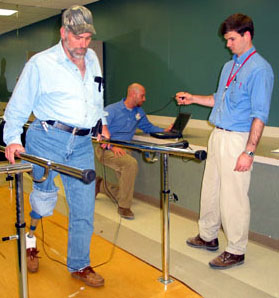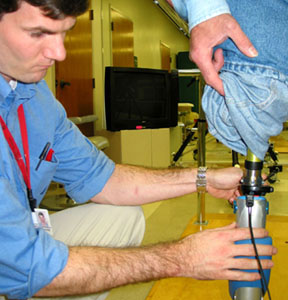JACKSON, Miss.—When Michael Savage’s 3-year-old grandson Jordan Reece heard that Papaw was getting a “new leg” his eyes got big and he said: “From Wal-Mart?”
Savage had to laugh. His Otto Bock C-Leg is hardly something you could find at the local discount store.
Featuring onboard sensors and a built-in micro-computer, the C-Leg is a technological marvel that is giving people with high-level amputations the confidence to walk again, said Chris Wallace, director of Methodist Orthotics and Prosthetics, a division of Methodist Rehabilitation Center in Jackson, Mississippi.
“The C-Leg can analyze your gait 50 times per second and automatically adjust the prosthetic knee joint to adapt to different terrain. It’s like having an onboard clinician making adjustments as you take each step,” Wallace said.
A resident of Poplar Grove, Ark., Savage came to Methodist to be custom-fitted with the C-Leg after losing his right leg in an industrial accident on May 21 in Newton, Mississippi.
Savage said he was preparing to work on a steel mill’s 60,000-pound transformer, when the unit tipped over on him. The weight sliced off his right leg at the hip, crushed the femur in his left leg and severed the toes on his left foot.
“A very high percentage of people with that amputation level have traditionally used a wheelchair or crutches,” Wallace said. “But enhancements like the C-Leg have increased the number of successful users in that category.”
Wallace said the Methodist Orthotics and Prosthetics staff—which includes eight certified practitioners—has fitted more than 25 C-Legs since the prosthesis was introduced in the United States in 1999. Three have gone to high-level patients like Savage.
Savage’s quick mastery of the leg has amazed his therapists, but they say his success isn’t just a triumph of newfangled technology. Old-fashioned stubbornness played a role, too.
The former firefighter, farmer and would-be electrician won’t settle for anything less than the most active lifestyle possible. “What else can you do?” he asks. “I’m sitting up looking at daisies, not pushing them up.”
The fact that he’s not in the ground says a lot about his grit. Even as he lay under the transformer—fully aware that his right leg was gone—Savage was directing rescue efforts.
“I was the only one who was calm,” he said. “Everyone else was going bananas and ballistic. I was telling them someone is going to have to go raise the door so the rescue equipment can come in.
“I got tickled at the ambulance driver. He had heard that a man was mashed under 60,000 pounds and I knew he thought he was going to scoop up a body and take it to the funeral home.”
Instead, Savage was rushed to the University of Mississippi Medical Center in Jackson, where he received 78 units of blood and eventually underwent 15 surgeries. He spent a month in a coma, and at least six times his heart stopped beating.
“They told us in the bat of an eye he could be gone,” said his dad John Savage.
Once his survival seemed assured, Savage, 48, turned his focus to “getting up and walking out.” But not everyone thought that was achievable. “Most people were saying I wouldn’t walk again because my left leg was so damaged and I had no right hip,” he said.
“People wanted us to send him to Memphis or Little Rock,” said his dad. “But we went to Methodist Rehabilitation Center because they were determined to make him walk. The therapists here have done wonders for him.”
Savage, in turn, has kept the Methodist staff amazed and amused. Around Halloween, he was hopping around without his prosthesis singing: Trick or treat, smell my foot, give me something sweet to eat.
“He’s a cross between Dennis the Menace and Superman,” says Latisha Yablon, a physical therapist at Methodist. “He’s totally a risk-taker, but he’s someone who has realistic goals. He had the attitude and determination to go above and beyond and challenge himself.”
Standing tall, with his broad shoulders once again filling out his extra-large shirt, Savage now looks like a man who has willed himself to be a winner. But when he first arrived at Methodist in July, he was 75 pounds lighter and extremely weak from months of bed rest.
“He couldn’t stand for more than a minute,” said Methodist occupational therapist Ashlee Dangelo. “It’s amazing what he has overcome. Now he can walk just using one forearm crutch.”
Savage said his recovery has been enhanced by Methodist’s team approach to treating patients with amputations. Because his physician, prosthetists and physical and occupational therapists are all under one roof, they’ve been able to make timely adjustments to everything from the fit of his leg to the focus of his therapy sessions.
Savage also has benefited from input from Methodist prosthetist Brad Kennedy. An above-the-knee amputee himself, Kennedy was among the first C-leg users in the United States and now travels the country training other practitioners on how to fit the leg.
“He knew how to tell me how to get around easier,” Savage said. “It took a month before I quit watching my feet and legs.”
Kennedy said after wearing a C-Leg for a while, you come to trust the computer’s ability to make adjustments and you become less worried about falling. “You’re able to relax more and enjoy your surroundings. It offered me so much more stability, my activity level increased 200 percent. Now it’s nothing to go downstairs with a book in one hand and a cup of coffee in another and not think about it.”
The C-Leg’s ability to navigate stairs is credited with helping an amputee survive the 911 terrorist attack on the World Trade Center. And it’s now considered the leg of choice for veterans who have above-the-knee amputations and want to return to duty.
Wallace says an advantage of the C-Leg is it can be fine-tuned to fit each patient’s gait. “We actually can hook the leg up to a computer using a fiber optic cable. While the patient is walking, we can analyze parameters such as how much force is being applied to the foot or heel or how fast the knee is swinging when flexed. The goal is to have as normal and efficient a gait as possible.”
Savage gets a kick out of all the C-Leg’s high-tech features, including the ability to recharge the limb while he’s on the road. “You know how you get in someone’s car and say, ‘Mind if I smoke?’ I say: ‘Mind if I plug into your cigarette lighter and charge my leg?”
Chances are the leg will need plenty of re-charging, as Savage is more than ready to reclaim his active lifestyle. “I’ve always been an active outdoor person,” he said. “I hate to sit. If I hadn’t gotten the C-Leg, I would have been in the shop making one.”
For more information about Methodist Orthotics and Prosthetics or the C-Leg, go to methodistonline.org or call 601-936-8899.
Methodist Orthotics and Prosthetics was one of the first sites in the nation to fit amputees with the Otto Bock C-Leg—the world’s first completely microprocessor-controlled artificial leg. The division is recognized by the American Board of Certification as a center of excellence.


